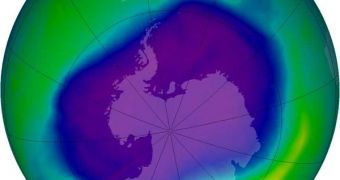Atmospheric scientists have recently determined that the hole in the ozone layer above Antarctica grew as big as it ever were this August, prompting speculations as to what may be the cause. Early data indicate that the chemicals responsible for the phenomenon take a long time to dissipate.
The world has largely stopped producing chlorofluorocarbons (CFC), the class of chemicals that has been directly linked with the emergence of the large hole in the ozone layer. Still, these dangerous chemicals can persist in the atmosphere for 50 to 100 years.
University of Cambridge Department of Chemistry atmospheric composition expert Dr. Neil Harris took a closer look at the issue recently, to mark the annual International Day for the Preservation of the Ozone Layer, which is also known simply as Ozone Day.
He explains that scientists at the British Antarctic Survey (BAS) – the same who discovered the hole decades ago – are constantly keeping an eye on its evolution, even though many countries around the world appear to think that the problem has been taken care of.
BAS investigators signaled that the 2011 ozone hole is very large, although whether this is related to global warming or not has yet to be established. Over large parts of the stratosphere, the lowest temperatures for the last Antarctic winter reached -80 degrees Celsius.
Interestingly, the ozone hole formed a lot earlier this year, and grew a lot faster than usual. However, atmospheric scientists are convinced that the formation will not grow even larger in the coming weeks.
According to statistics, dangerous chemical levels have decreased in Earth's atmosphere by as much as 5 to 10 percent since the Montreal Protocol regulating CFC emissions has been signed. Still, given the half-life these substances have, the actual decline in ozone hole sizes is a lot smaller.
“The reason is probably to do with the complex interaction between the ozone depletion and climate change,” Harris explains. The researcher was involved in studying atmospheric ozone concentrations himself for many years.
“If the lower part of the atmosphere warms, then the upper part has to respond. Both are happening in the same atmosphere, so it is simplistic to think that the two phenomena are isolated,” he adds.
“The links between the two are poorly understood, certainly not enough to make firm predictions about what will happen. It is important for understanding future ozone levels; it is also important because the stratosphere will modulate climate change,” he concludes.

 14 DAY TRIAL //
14 DAY TRIAL //